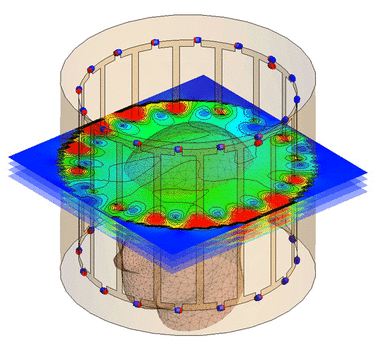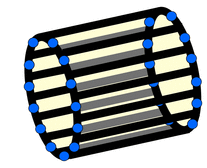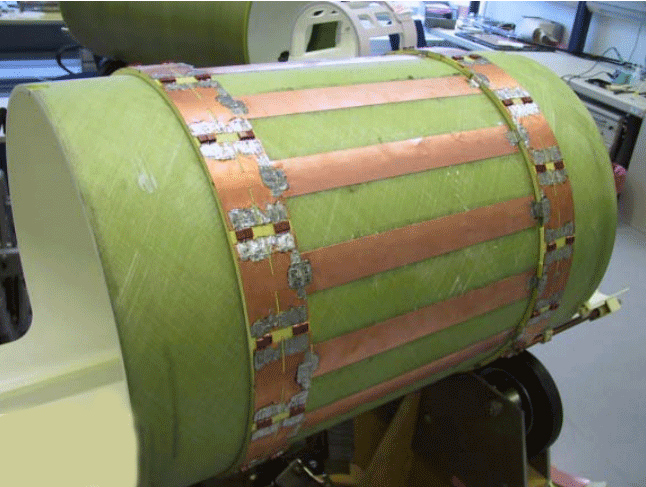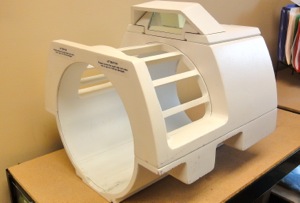Birdcage Coils
In transmit operation sinusoidal currents are applied to each rung that are sequentially phase shifted around the coil's periphery. If there are N rungs, the phase shift between the currents in neighboring elements is 360°/N. According to antenna theory whenever the current distribution over a cylindrical surface satisfies sinusoidal angular dependence, a resonant condition exists and a homogeneous magnetic field can be created inside the conductor.
Some insight into the generation of a circularly polarized B1 field can be appreciated by considering the diagram below showing a hypothetical 6-rung birdcage coil. The current in each rung is directed into the page (denoted by ✕ arrow ends). The curved local fields generated around each rung are drawn according to Maxwell's right-hand rule. Each rung is driven by a sinusoidal current, but the peak current of each successive rung is delayed by 360°/6 = 60°. As each rung peaks in turn the central magnetic field is seen to rotate. This is an RF-resonance phenomenon called the first mode, or homogeneous mode of the coil.

Magnetic field map inside a birdcage coil.
(Courtesy of P. Futter, computed with FEKO) |
Advanced Discussion (show/hide)»
A few additional notes on birdcage coils. . .
The standard operation of birdcage coils is in the first (homogeneous) mode as this produces a uniform B1 field suitable for MRI. In a coil with N rungs, however, there are actually N/2 modes. These higher order modes are characterized by a faster phase rotation around the coil. Because these higher order modes set up inhomogeneous field distributions, they are unsuitable for routine excitation, but can be used for parallel RF-transmission and MR signal detection under certain conditions.
Birdcage coils are relatively easy to design at fields of 1.5T and below, but at higher fields there is appreciable coupling with the patient and various "near field" effects must be considered. A common technique at very high fields is to drive the coil from more than 2 ports allowing better control of the RF-field produced.
A variety of birdcage variant coils exist, including spiral, double spiral, woven, and multiple ring types.
Hayes EC, Edelstein WA, Schenck JF et al. An efficient highly homogeneous radiofrequency coil for whole-body NMR imaging at 1.5 T (pdf). J Magn Reson 1985;63:622–828.
Gurler N, Ider YZ. FEM based design and simulation tool for MRI birdcage coils including eigenfrequency analysis (pdf). Proceedings of 8th Annual Conference on Multiphysics Simulation and its Applications, Milan, 2012.
What are the function(s) of radiofrequency (RF) coils?
I don't understand all the different types of coils in MR. Can you make sense of these?
What are TEM coils?



